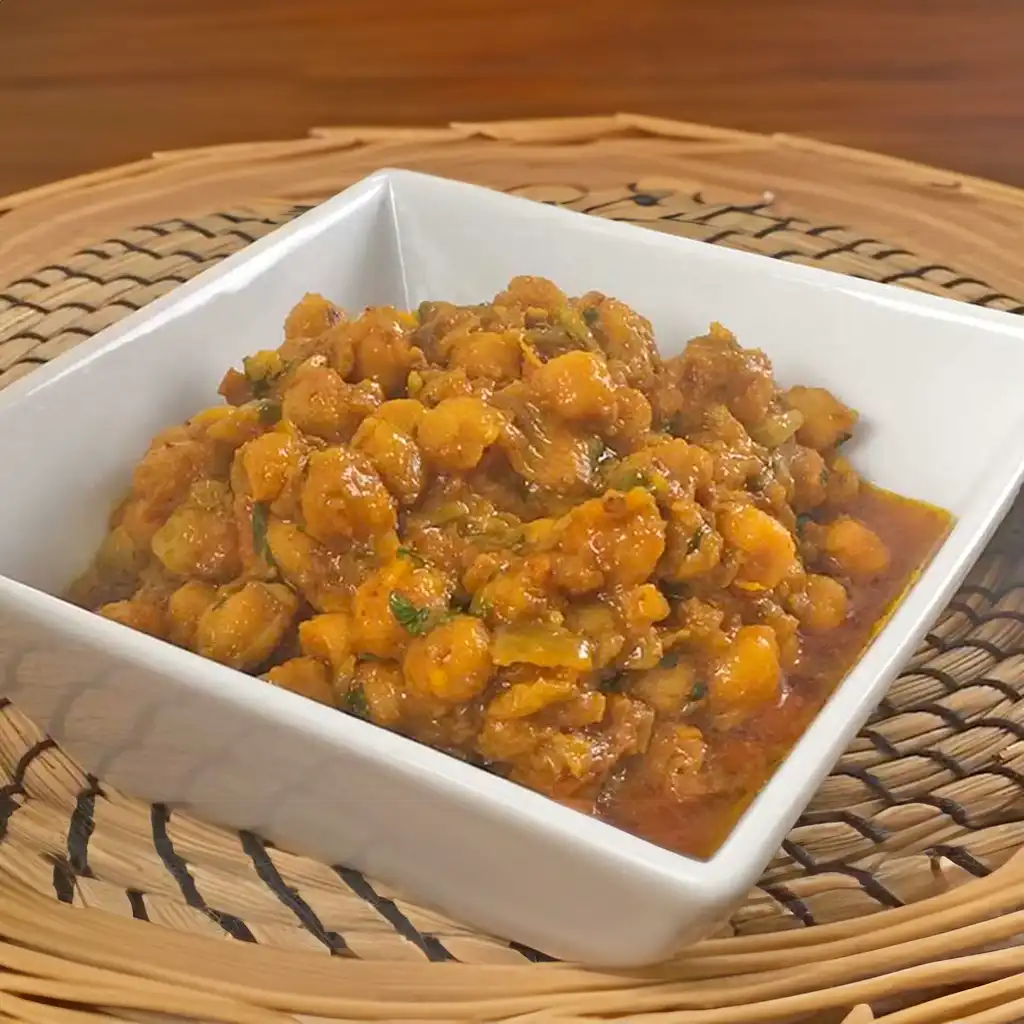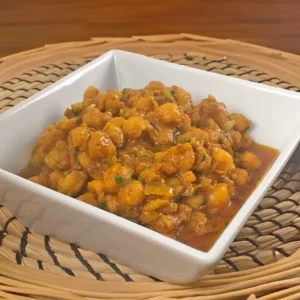
Chana Curry, a traditional Indian dish bursting with flavor and warmth, has been a staple in many households for generations.
Originating from the Indian subcontinent, this dish offers a delightful blend of spices and aromatics, making it a favorite among both vegetarians and meat-lovers alike.
Crafting a perfect Chana Curry requires a balance of spices, patience, and love. While it may seem daunting at first, fear not, as this recipe is suitable for beginners willing to embark on a culinary adventure.
In this recipe, tender chickpeas are simmered in a fragrant tomato and onion-based sauce, infused with aromatic spices like turmeric, cumin, and chili powder.
The slow cooking process allows the flavors to meld together, resulting in a rich and hearty curry that is sure to tantalize your taste buds.
Whether you’re craving a comforting meal for a cozy night in or planning a gathering with friends and family, Chana Curry is the perfect dish to satisfy your hunger and warm your soul.
Expert Tip: Experiment with additional ingredients to customize your Chana Curry to your liking. Consider adding diced potatoes, spinach, or bell peppers for extra flavor and nutrition.
Chickpeas (Chana): Chickpeas serve as the heart of this dish, providing a hearty and satisfying texture. They’re rich in protein and fiber, making this curry not only delicious but also nutritious.
Olive Oil: Olive oil adds a smooth richness to the curry while also imparting a subtle fruity flavor. It helps to sauté the onions and tomatoes, enhancing their natural sweetness.
Onions: Onions form the base of the curry, lending a sweet and savory depth of flavor. When cooked down, they become soft and caramelized, adding richness and complexity to the dish.
Garlic Paste: Garlic adds a bold, pungent flavor to the curry, complementing the sweetness of the onions and tomatoes. It also offers numerous health benefits, including boosting the immune system and reducing inflammation.
Tomatoes: Tomatoes provide acidity and brightness to the curry, balancing out the richness of the chickpeas and spices. They break down as they cook, forming a luscious sauce that coats the chickpeas beautifully.
Turmeric Powder (Haldi): Turmeric not only adds a vibrant yellow hue to the curry but also offers earthy undertones and a subtle bitterness. It’s known for its anti-inflammatory properties and adds depth to the flavor profile.
Chili Powder: Chili powder brings heat and spice to the curry, adding a kick of flavor without overwhelming the dish. Adjust the amount according to your preference for spiciness.
Salt: Salt enhances the flavors of the other ingredients and helps to balance out the dish. Be mindful not to add too much, as you can always adjust the seasoning later.
Cumin Powder (Jeera): Cumin adds a warm, nutty flavor and a hint of smokiness to the curry. It pairs perfectly with the other spices and elevates the overall taste of the dish.
Green Chilies: Green chilies provide freshness and a subtle heat to the curry. You can adjust the amount depending on your spice tolerance.
Coriander (For garnish): Fresh coriander adds a pop of color and freshness to the finished dish. It’s used as a garnish to add a final touch of flavor and visual appeal.
Expert Tip: For a creamier texture, mash some of the cooked chickpeas against the side of the pot using a spoon or potato masher before serving. This will thicken the curry and create a luscious consistency that coats the chickpeas beautifully.
Expert Tip: To enhance the flavor of the Chana Curry, toast the whole spices such as cumin seeds and coriander seeds before grinding them into a powder. This extra step helps release their essential oils, resulting in a more aromatic and flavorful curry.
Chana Curry typically takes around 1 hour to cook, but the cooking time may vary depending on factors such as the freshness of the chickpeas and the desired level of tenderness. Be patient and allow the flavors to develop slowly for the best results.
Yes, you can use canned chickpeas as a time-saving alternative. However, keep in mind that canned chickpeas are already cooked, so you’ll need to adjust the cooking time accordingly. Simply skip the soaking and boiling steps and proceed directly to adding the canned chickpeas to the curry.
The level of spiciness in Chana Curry can be adjusted according to your preference. This recipe includes chili powder and green chilies for heat, but you can reduce the amount of spice if you prefer a milder flavor. Feel free to customize the heat level to suit your taste buds.
Yes, Chana Curry can be made in advance and stored in the refrigerator for up to 3-4 days. In fact, the flavors tend to develop even further after sitting overnight, making it a perfect make-ahead dish for busy weeknights or meal prep.
Yes, Chana Curry freezes well and can be stored in an airtight container in the freezer for up to 2-3 months. Simply allow the curry to cool completely before transferring it to freezer-safe containers. When ready to enjoy, thaw the curry overnight in the refrigerator and reheat gently on the stovetop or in the microwave until heated through.
Here are some more recipes for you to enjoy! If you my recipes don’t forget to rate and leave a comment.
If you have any recipe suggestions, please do not hesitate to ask me. A great way to stay in contact with me is through Instagram, Facebook, Twitter and YouTube. Don’t forget to tag me @CookwithNabeela in your recipe photos!

Subscribe now to receive my latest recipes directly in your inbox. Stay up-to-date and never miss out!

I love to cook! I want to share with you my favourite, delicious family-friendly recipes. I want to inspire you to create fantastic food for your family every day.
Latest comments (14)
Hi. I’ve tried a few of your curry recipes now, Keema, Vegetable, Chicken and more. They are all really easy to follow and taste fantastic. Thank you. I thought I’d try a Chana curry next but wanted to check how much oil you use first. The recipe shows 150ml of oil. Is this right?…seems an awful lot but you obviously know best 🙂
Thank you so much for the lovely feedback! 😊 You’re right, 150ml is a bit much—it’s from an older version of the recipe. You can use anywhere between 50-100ml, depending on your preference!
This is so delicious! My first time making and I was amazed at how authentic and delicious it was!!!
Hi, can I ask, do you use 500g of dried chickpeas?
Hi, This chana curry is an absolute delight! The combination of tender chickpeas, aromatic spices, and rich, flavorful curry sauce creates a perfect harmony of taste and texture.
Each bite is a burst of savory goodness that leaves you satisfied and craving more. A must-try for anyone who appreciates the heartiness and warmth of a well-prepared curry.
Thank you so much for your kind words! I’m thrilled you enjoyed the chana curry. It’s definitely a favorite in our household too. If you have any other recipes you’d like to recommend or try, feel free to share!
Hi, can this be cooked in instant pot?
Yes, you can definitely cook this in an Instant Pot. Just remember to reduce the cooking time accordingly. Enjoy!
Coriander? What coriander? The end says add coriander but there is none in the recipe??
Thanks for your comment! It’s easy to miss sometimes, but coriander is in the recipe ingredients list and video. Enjoy making the recipe!
Made this recipe for first time this week. Simple to prepare and really good flavor!
Thank you! I’m glad you liked it 🙂
This is SO delicious. I am making it again today for the 4th time! I tried other versions but doesn’t meet up to this! Thank you so much!!
You are most welcome! I am glad you like my recipe 🙂